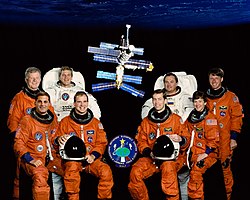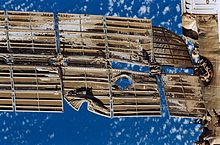STS-86
| Mission emblem | |||
|---|---|---|---|

|
|||
| Mission dates | |||
| Mission: | STS-86 | ||
| COSPAR-ID : | 1997-055A | ||
| Crew: | 7th | ||
| Begin: | September 26, 1997, 02:34:19 UTC | ||
| Starting place: | Kennedy Space Center , LC-39A | ||
| Space station: | Me | ||
| Coupling: | September 27, 1997, 19:58 UTC | ||
| Decoupling: | October 3, 1997, 17:28:15 UTC | ||
| Duration on me: | 5d 21h 30min 15s | ||
| Landing: | October 6, 1997, 21:55:09 UTC | ||
| Landing place: | Kennedy Space Center, Lane 15 | ||
| Flight duration: | 10d 19h 20min 50s | ||
| Earth orbits: | 169 | ||
| Rotation time : | 92.2 min | ||
| Apogee : | 392 km | ||
| Perigee : | 370 km | ||
| Covered track: | approx. 6.8 million km | ||
| Team photo | |||
 v. l. No. Front: Michael Bloomfield, James Wetherbee, Wendy Lawrence Back: Jean-Loup Chrétien, Scott Paraczynski, Wladimir Titow, Michael Foale |
|||
| ◄ Before / After ► | |||
|
|||
STS-86 ( english S pace T ransportation S ystem) is the mission designation for a flight of the US Space Shuttle Atlantis ( OV -104) of NASA . The launch took place on September 26, 1997. It was the 87th space shuttle mission, the 20th flight of the space shuttle Atlantis, the ninth flight as part of the Shuttle Mir program and the seventh coupling of a US space shuttle to the space station me .
team
- James Wetherbee (4th space flight), commander
- Michael Bloomfield (1st spaceflight), pilot
-
Wladimir Titow (5th space flight), mission specialist ( Roskosmos / Russia )

- Scott Parazynski (2nd space flight), mission specialist
-
Jean-Loup Chrétien (3rd space flight), Mission Specialist ( CNES / France )

- Wendy Lawrence (2nd spaceflight), mission specialist
Me crew outbound
- David Wolf (2nd space flight)
Me crew return flight
- Michael Foale (4th space flight)
(Returned to Earth after a flight time of 144 days, 13 hours and 48 minutes; one-way flight on STS-84 )
Mission description
During the seventh Shuttle-Mir docking mission, a crew member was swapped in addition to supplies and experimental material. Michael Foale returned to earth after a good four months and was replaced by David Wolf. Originally, Wendy Lawrence was planned as a Mir astronaut, but her size did not match a spacesuit of Russian origin. In addition, after the collision of the transport spaceship Progress-M 34 with the station's Sp exc module, there had been long discussions about whether NASA would even send another spaceman to the station. Ultimately, the decision was made to gain experience in the field of crisis management in space stations .
After preparing and checking the coupling mechanism and installing the target camera, the Atlantis docked at the Mir space station on September 27th . For six days, more than four tons of material were transported in both directions: water, spare parts and experimental equipment as well as samples to the station - process water, disused technology and research results from it. The latter mainly consisted of data carriers and biological samples, such as a plant experiment and beetles whose biorhythm had been studied over a long period of time.
During the joint flight, the vibrations of the individual station modules were measured under different loads (experiment MEEP ), on the one hand when the maneuvering engines of the space shuttle were fired , and on the other hand during the athletic training sessions of the space travelers. These data should still flow into the construction of the international space station. Since the position control was largely taken over by the Atlantis, a new control computer could be installed in the station. It regulated both the orientation of the station in space and the orientation of the solar panels . Without this control, the maximum possible energy would not have been available in the station.
On October 1st , Vladimir Titov and Scott Parazynski disembarked from the space shuttle for five hours and one minute. They dismantled some experiments on the outside wall of the shuttle docking module , which were used to measure the environmental conditions near the station for 19 months. They also took a special cover from the Atlantis hold and attached it to the outer shell of the Mir space station. It should be mounted above the fastening of the damaged solar cell surface on the Spektr module and seal the suspected leaks there.
After the space shuttle was decoupled from the station, the damaged module was briefly pressurized twice. The escaping gas condensed and formed bubbles. The escape of the bubbles could both be observed and photographed. With this one hopes to be able to localize the small leaks. The Atlantis flew around the station after casting off.
The routine experiments in the Spacehab (double module in the loading bay of the Atlantis) and the middle deck of the shuttle included the recording of all cosmic radiation components within the spacecraft (Radiation Monitoring Experiment RME).
With a previously installed special seat for the long-term plane Foale, the Atlantis landed in Florida a day later than planned. The reason for the postponement of the return was bad weather.
See also
Web links
- NASA Mission overview (English)
- Video summary with comments of the crew (English)


